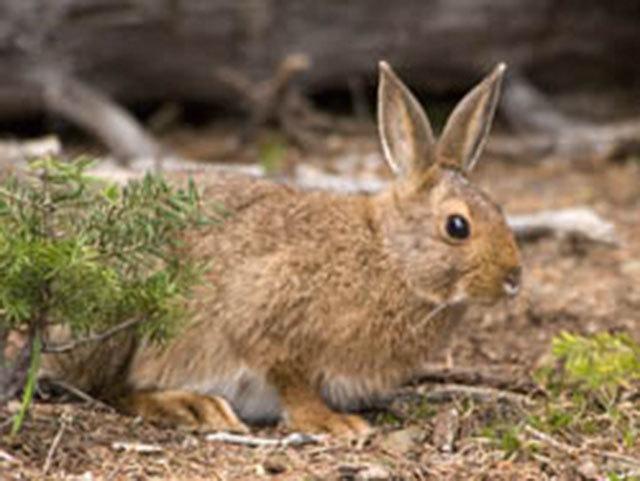You wouldn’t think it, but a brown hare sitting stock still in your garden is amazingly hard to see.
That is, until it blasts out of the lettuce at your feet in seemingly instantaneous acceleration to nearly 30 miles per hour in a bewildering zigzag.
And that’s with a belly full of salad.
We don’t see ours very often in the Olympics. They’re crepuscular, meaning they like early mornings and late evenings best. Not as fast as their desert cousins, snowshoe hares rely on their excellent hearing to avoid predators and will freeze until the last instant. They like thick brush and hardly ever wander around in the open.
Cross-country skiers often see their tracks in the snow, but hardly ever the hide or hare. Their home ranges are really small; a lot of them will spend their whole lives inside just a few acres.
People who hunt them say a dog-chased hare very often circles back, apparently reluctant to leave its home area.
Hares unwittingly supply protein to food webs wherever they live and any predator who can catch them eats them like popcorn. Coyotes, wolves, cougars, bobcats, weasels, lynx, foxes, owls, etc.
(In the Olympics here we have no lynxes or wolves and very few foxes.)
You know those red-tailed hawks you see on poles next to the highway? They eat a lot of voles, but if they nail a hare, they get the rest of the day off.
In winter most other prey animals are under ground or snow and hares are the only thing left in the cupboard. It’s estimated that 85 percent of snowshoe hares don’t survive their first year.
Hares make up for these huge losses by reproducing “like rabbits.” The female, or “jill,” requires a chase to get in the mood and quality mates are the “bucks” able to catch her. Females can produce several litters of 4-6 “leveretes” per year and the young often just sort of pop out while she goes about her business.
There isn’t really any nest, maybe just a scrape under some bushes where the female hangs out during the day and the young are sometimes born there. They come out fully furred and able to hop around and eat right away, kind of like a chicken chick.
That’s the biggest difference between hares and rabbits. Hares give birth to precocial young, which are pretty much ready to go at birth. Females nurse only casually for a couple of days and then the young are on their own.
We don’t have any wild rabbits like cottontails in the Olympics, but if we did, they’d give birth to altricial young, which are blind and hairless and require weeks of delicate care and feeding (like you did).
For some unknown reason, hare populations vary wildly on about an 8-11-year cycle and their predators’ numbers follow suit, especially the single-minded lynx. (There’s a famous graph of Hudson Bay hare and lynx fur records over many years that beautifully illustrates the relationship between predator and prey. Google “hare and lynx populations” and you’ll see what I mean.)
Elderly hares are extremely rare and no more than 5 years old. I know of a captive hare that is about 10.
They eat a variety of grasses, leaves, forbs, twigs, bark and garden vegetables. Sometimes in winter they’ll girdle small trees at top of the snow. They will sometimes nibble dead animals, especially in winter.
If you were thinking of being a hare in your next life, please consider the following: Like many lagomorphs (rabbits and hares) and some rodents, hares are coprohagous, meaning they eat their own poop, um, all the time.
I’m not one to criticize lifestyles, but hares and rabbits have been around for over 30 million years! Come on! Couldn’t they have come up with a better digestive system by now?
Well, apparently they need to run their food through twice in order to squeeze out all the nutrients. Often eaten right from the source, but for some members of this family, bacteria that perform some crucial stage of food breakdown must have sunlight to complete their job.
If I remember correctly, animals that rely on these kinds of digestive bacteria will slowly starve if deprived of their sunlight-ripened poops.
Adults weigh about 3-4 pounds, the females a little bigger. The “snowshoe” hind feet are about 4-6 inches long and covered with dense fur with stiff hairs on the bottom and between the toes. Snowshoes live throughout Canada south of the treeline, across northern United States and south along Appalachian, Rockies, Cascades, Sierra and into the Olympic mountains.
Over most of their range, they famously exchange brown summer coats for elegant white in winter. The changes are triggered by day length, not temperature, and years where snow comes early or stays late, they are pretty conspicuous for a few weeks.
Here in the Olympics and some other parts of their southern range, they stay brown all year.
Tom Butler has a degree in zoology from the University of Washington and is a lifelong student of nature. He lives in Port Angeles and can be reached at butlert@olypen.com.



